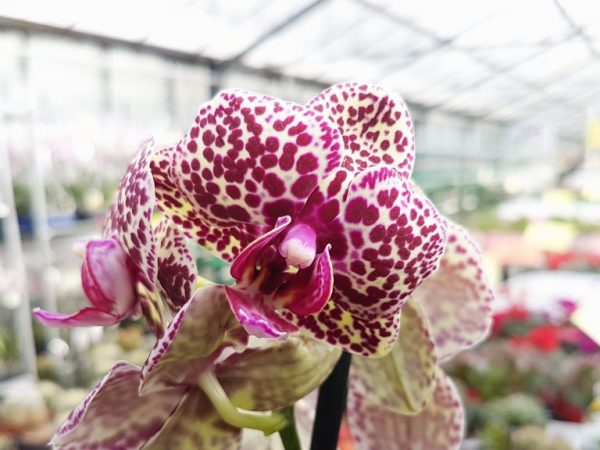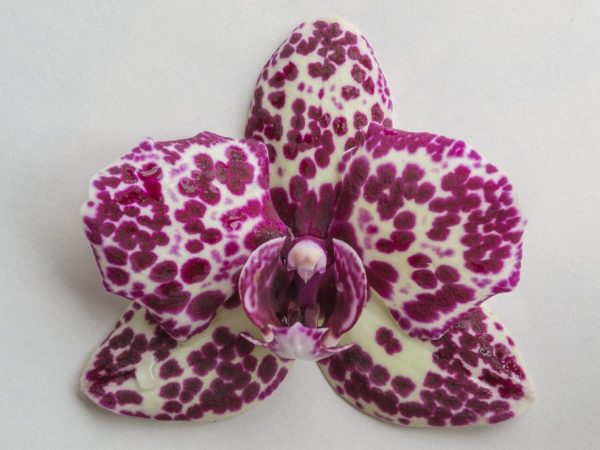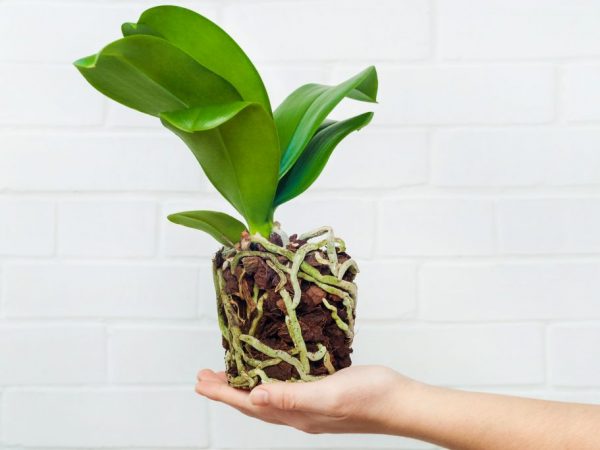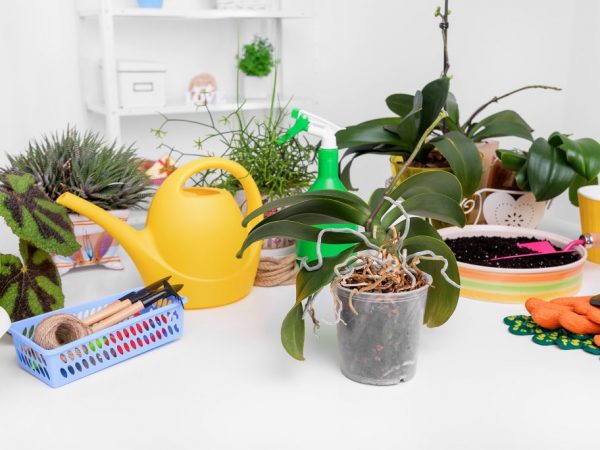Growing an orchid wild cat
The genus Phalaenopsis from orchid plants has more than 70 species. Recently, a large number of hybrids have appeared. There are those that are more common, and there are also especially rare ones. Orchid Wild cat is one of the rare representatives.

Growing an orchid wild cat
Description of the variety Wild cat
Wild cat is a varietal orchid, one of 20 rare phalaenopsis species. Phalaenopsis The wild cat has inherited a good genotype and a noble look. Australia and the Philippines are considered his homeland. According to the description, the orchid is characterized by a bright color: purple-purple spots on a white or pale yellow background. Depending on the habitat and the conditions created, spots are large and small, dark or light. The flower is covered with a dense waxy coating, which causes the color saturation.
This type of orchid is relatively easy to care for compared to other varieties, for example, Korolevnaya or Fly-eater. A wild cat is able to bloom twice a year, releasing a peduncle up to 55 cm. The flowers are large, about 11 cm in diameter, with a light pleasant aroma.
Growing an orchid
The Korona pot is ideal for growing. It is made of durable and transparent plastic and consists of a through needle structure and flexible rods arranged in a circle, with gaps, and holding the ground. The pallet is included, it must be used to create drainage.
The pot is suitable for phalaenopsis, because their roots take an active part in photosynthesis and require light access to the root system. Problems associated with the growth of orchids most often arise from improper care.

Orchid keeping conditions
Possible errors and their consequences:
- excessive watering leads to rotting of the root system;
- an excess of fertilizer leads to drying of the roots;
- the absence of a difference between day and night temperatures reduces the frequency of flowering.
Sprout propagation
The Wild Cat Orchid has the only way of reproduction - by children. Their appearance is possible at a high room temperature. If necessary, the plant is stimulated:
- a semicircular incision is made with a sharp instrument in the kidney, which is closer to the base of the arrow;
- the incised scales are removed with tweezers and the emerging kidney is treated with any growth stimulant.
After 25-35 days at a temperature of 24 ° C-30 ° C, a baby will appear. After the appearance of roots 2-3 cm in size, they are planted in moss or in a mixture of a fine fraction of the bark.
Phalaenopsis care
The orchid will die if the conditions of detention do not meet the requirements of the phalaenopsis.
Transfer
Orchids do not like transplants, they experience a lot of stress and take a long time to adapt to a new place of residence. A transplant is necessary only in the following cases:
- Roots are rotting or damaged. Damaged and dead areas are removed, the cut sites are sprinkled with activated carbon or cinnamon powder. The orchid is transplanted into a new container with a new substrate.
- Instability of the plant in the ground, lack of the latter or tightness of the roots. The flower is transplanted, it is given time to adapt. The transplant is carried out no more than 2-3 times a year. Cut the old pot so as not to damage the roots. A drainage of 2 cm is poured at the bottom, small pieces of polystyrene are placed under the root collar, then the plant is carefully lowered into a container where the voids are filled. Pieces of charcoal are added to the bark.

Orchid transplant is only necessary in special cases.
In the finished substrate, steamed pine bark, moss, charcoal, fern root, coconut chips and an inert material such as expanded clay are most often added to it.
The soil must have the following qualities:
- dense structure, which is a support for the plant;
- high water and air permeability;
- the ability to retain nutrients well.
After purchase, the plant must adapt to new conditions. The orchid is not watered, except for too dry soil, fertilized and sprayed. A place with diffused sunlight is selected and a flower is placed there for 7-10 days. If the flower is healthy and blooming well, there is no need for a transplant. In the purchased container, the orchid can grow for several more years.
Temperature regime
The optimal temperature regime during the day is from 22 ° С to 25 ° С, and at night it is 5 ° С-6 ° С lower. The main thing is not to allow a decrease to 15 ° C.
The air humidity is kept in the range from 40 to 70%. The room is periodically ventilated, but drafts are unacceptable. The flower should be in such a place that it has enough illumination, and at the same time it does not fall on direct sunlight. The lighting period required by the orchid is at least 10-12 hours a day.
Watering
Plants tolerate a lack of water more easily than an abundance of water, and yet watering is one of the most important components of care. After watering, the substrate is allowed to dry. The amount and sequence of watering is based on monitoring the root system and soil.
Top dressing of the substrate is carried out at every third watering. As a fertilizer, the concentration of feeding for orchids, reduced by 1.5-2.5 times, is used.
Stimulation
After flowering, the plant needs to rest in order to gain strength and grow in a couple of months. Phalaenopsis do not have a pronounced period and dormancy, the flower may not bloom for a long time and at the same time develop. In this case, they resort to stimulation.
Common methods of stimulation:
- We monitor the weather, 2-3 days before the cold snap, we stop watering and spraying. After 15-20 days of dry cooling, a peduncle appears in the deciduous sinuses.
- Change 1/5 of the top layer of the substrate, remove part of the top layer of the bark and add Azalea soil.
- We use 5 pcs. crystals of AVA fertilizer without nitrogen.
Diseases and pests
Dikiy Kot is characterized by diseases such as gray rot and fusarium. Any fungicide is suitable for their treatment. Insecticides are used to kill spider mites and thrips.

The orchid is susceptible to diseases such as gray rot and fusarium
Pest control
To combat any pests, the preparations "Marsh" and "Borey" are needed.
For ticks use "Aktelik" or a drug with a large spectrum of action. Absolutely all drugs are diluted in 1 liter of water (sachet or ampoule). The concentration should be 10 times more than indicated in the instructions.
The resulting solution is thoroughly sprayed on all sides of the plant so that the drug passes through the substrate. They wait for the drops on the leaves to dry and return the plant to its place. It is allowed to spray and wash the flower no earlier than 20-30 days after treatment. To consolidate the result, the treatment is repeated after 7-10 days.
The number of pests is growing rapidly, therefore, the treatment is carried out for all plants.
Prophylaxis
After buying a new phalaenopsis, store soil is treated with fungicides and insecticides. For this, it is best to use warm and soft water.
Conclusion
This type of phalaenopsis is one of the most beautiful.He is undemanding to the conditions around him. Even a beginner can grow a Wild Cat orchid. Proper care of her will be the key to a long and lush flowering.

